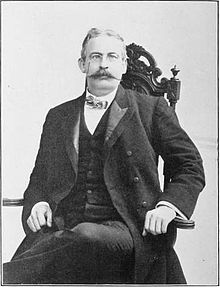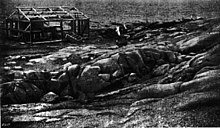Walter Wellman
Walter Wellman (born November 3, 1858 in Mentor , Ohio , † January 31, 1934 in New York City , New York ) was an American airship pioneer. In 1905, the reporter was commissioned by the Chicago Record Herald to be the first person to cross the North Pole in an airship in an effective way .
Polar expeditions
As early as 1893 he had started his attempts to reach the North Pole from Spitzbergen . A year later he was convinced that the only way was through the air.
He had his first experience in polar regions in 1894 with the ship Ragnvald Jarl near Waldenøya in the north of Spitzbergen, where the ship sank. In 1898/99 he reached the northern tip of Franz Josef Land as the leader of an expedition . After Wellman broke his leg in an ice quake , he broke off the march to the North Pole. The greatest success of the expedition was the discovery of Graham Bell Island by Evelyn Baldwin .
At the Portsmouth Peace Conference in 1905, Wellman was enthusiastic about the French Lebaudy steering balloon. He was certain that he had found the right means of transportation with this device, which had a load capacity of 3750 kg (7500 lbs ). He called his project the "Wellman Chicago Record Herald Polar Expedition". The newspapers attacked Wellman mercilessly, accusing him of never really thinking about carrying out his daring plans. Wellman was annoyed and struggled constantly not to let the stories spread about him flow into his plans.

“Why is Wellmann making this trip now?” Wrote the Berliner Morgenpost . “Is it really scientific or sporting ambition, or is it an advertisement, as many people claim? It is not both. Wellmann has absolutely no intention of making the whole flight; he has nothing but the intention of daring the attempt. Before setting off on his unfortunate north polar journey, he said at a farewell dinner: 'We are the first to try to reach the pole in an airship. We cannot predict whether the attempt will succeed or not, even though we have done what is humanly possible. If it doesn't succeed, we are the first to tackle this problem. ' Here lies the key to his plan. First of all, the desire to be 'first' and to own the 'greatest' is one of the most salient national traits of Americanism. Then it should be remembered that he was in fact the first to try practically to reach the pole, in the airship of course. He did not succeed, but in the history of airship travel his name will always have to be mentioned in the first place if later flights to the pole are really successful. Even when flying over the ocean, which will sooner or later succeed, he is the first to try. "
After an unsuccessful attempt in 1906, Wellman succeeded in the summer of 1907 on Spitsbergen for a trip with his airship America of 24 kilometers. After a crash landing, he was rescued by the Frankfurt polar driver Theodor Lerner . An article in the Agramer Zeitung of July 2, 1907, which was based on a publication by The Record Herald (Chicago), referred to the preparations of the company .
A second flight on August 15, 1909 had to be canceled after 40 miles due to technical problems. After Salomon August Andrée in 1896/1897, this was the second attempt to cross the pole by air. In 1910, by the way, Ferdinand Graf von Zeppelin , accompanied by the polar explorer Erich von Drygalski and the meteorologist Hugo Hergesell, traveled to Spitsbergen to assess the chances of such an undertaking. In memory of Wellman's pioneering achievements, the Wellman Glacier in Antarctica bears his name.
Atlantic crossing
In 1910 Wellman tried to cross the Atlantic with his airship America . He started in Atlantic City . As is evident from contemporary newspaper reports, the exact destination of the Atlantic crossing in Europe should be selected depending on the prevailing weather conditions during the journey. Because of the short distance, England was primarily considered, which should be reached on the transatlantic shipping route. This attempt failed due to extreme weather conditions about 1,600 km from the coast in the ocean. With his emergency call, Wellman sent the world's first radio message from an airship to a sea vehicle. It read: "Roy, come and pick up that goddamn cat." That meant the cat Kiddo, who had smuggled himself onto the airship as a stowaway.
At the end of the journey, the airship was approximately at a position of 42 ° north latitude and 67 ° west longitude and by then had covered around 1,200 km in 72 hours. The recovery turned out to be very difficult due to the swell . The airship was moored to take up the crew on the SS Trent steamer called for help . After his inmates were rescued, he was severed and the America rose to heaven without a leader.
The America's lifeboat was later included in the equipment of the 1911-built Akron , which however crashed during a test drive on July 2, 1912. It was also built for an Atlantic crossing.
Airship America
Wellman had his airship converted and enlarged several times. His aim was to keep the engine running as long as possible at a moderate speed of around 18 mph (29 km / h).
literature
- W. Wellman: The Aerial Age . Keller, New York 1911
- PJ Capelotti: By Airship to North Pole: An Archeology of Human Exploration . Rutgers Univ. Press, New Brunswick 1999. ISBN 978-0-8135-2633-1
- Th. Lerner: Polar driver. Under the spell of the Arctic. Oesch-Verlag, Zurich 2005. ISBN 978-3-0350-2014-4
Individual evidence
- ^ PJ Capelotti: EB Baldwin and the American-Norwegian discovery and exploration of Graham Bell Island, 1899 . In: Polar Research . Volume 25, No. 2, 2006, pp. 155-171. doi : 10.3402 / polar.v25i2.6245
- ↑ Walter Heichen: Adventure of the air - The progress of airship travel in free balloon, airship and airplane . Phoenix publishing house, Berlin, Breslau, Kattowitz, Leipzig 1912.
- ^ Agramer Zeitung of July 2, 1907 ( ANNO digitized version ).
- ↑ Compare the newspaper article Wellmann's airship expedition to the North Pole in: Neue Freie Presse from August 18, 1909 ( ANNO digitized version ).
- ↑ On the preparations, see the article in the Neue Wiener Journal of September 17, 1910 ( ANNO digitalisat )
- ↑ Innsbrucker Nachrichten of October 17, 1910 ( ANNO digitized version )
- ^ New Vienna Journal of October 17, 1910 ( ANNO digitized version )
- ↑ Original: Roy, come and get this goddamn cat.
- ^ Allan Janus: Animals Aloft: Photographs from the Smithsonian National Air and Space Museum . Bunker Hill Publishing, Inc., 2005, ISBN 978-1-59373-048-2 , p. 28.
- ^ Die Neue Zeitung of October 20, 1910 ( ANNO digitized version )
- ↑ D'Orcy's airship manual; an international register of airships with a compendium of the airship's elementary mechanics; October 1917; The Century co. New York; Pages 177-179; online at archive.org ; last accessed on October 6, 2016
| personal data | |
|---|---|
| SURNAME | Wellman, Walter |
| BRIEF DESCRIPTION | American airship pioneer |
| DATE OF BIRTH | November 3, 1858 |
| PLACE OF BIRTH | Mentor , Ohio , United States |
| DATE OF DEATH | January 31, 1934 |
| Place of death | New York City , New York , United States |

